25 Women Changing the Future
Celebrating 25 years of revolutionary women.
Who would have thought 25 years ago—when Marie Claire first launched in the U.S.—that in 2019, there would be social media, self-driving cars, or a shot at colonizing Mars? To commemorate our first quarter century, we chose 25 women sure to leave their mark on the next, starting with our four cover stars.


Because the outspoken U.S. Women's National Soccer Team co-captain has emerged as a model for a new kind of activist athlete.
In case you didn’t notice, Megan Rapinoe had an excellent summer. There was the World Cup soccer victory, of course, and the Golden Ball trophy for best player, and the Golden Boot trophy for highest scorer. There was a whirlwind of television appearances: Jimmy Kimmel. Seth Meyers. Rachel Maddow. Good Morning America. Even Meet the Press, for God’s sake. Let’s not forget the ticker-tape parade through Manhattan, with the mayor handing her a key to the city. And, oh, were there parties! Rapinoe was everywhere, champagne in hand, pink hair gleaming under the spotlights. Her triumphal pose—arms outstretched, head thrown back, loving it, owning it—became an Internet meme. And in the aftermath of this dazzling athletic performance, something even grander became evident: Rapinoe and her 22 teammates on the U.S. Women’s National Soccer Team have served notice that strong, irrepressible, ass-kicking females are taking the world’s stage—and they’re not asking for anyone’s permission.
By now, the events have been stamped into history. Rapinoe, caught on video months before the 2019 World Cup began, was asked a hypothetical question: If the American women won the title, would they be excited to go to the White House? She looked startled for an instant, then shot back, “I’m not going to the fucking White House.” —Susan Casey
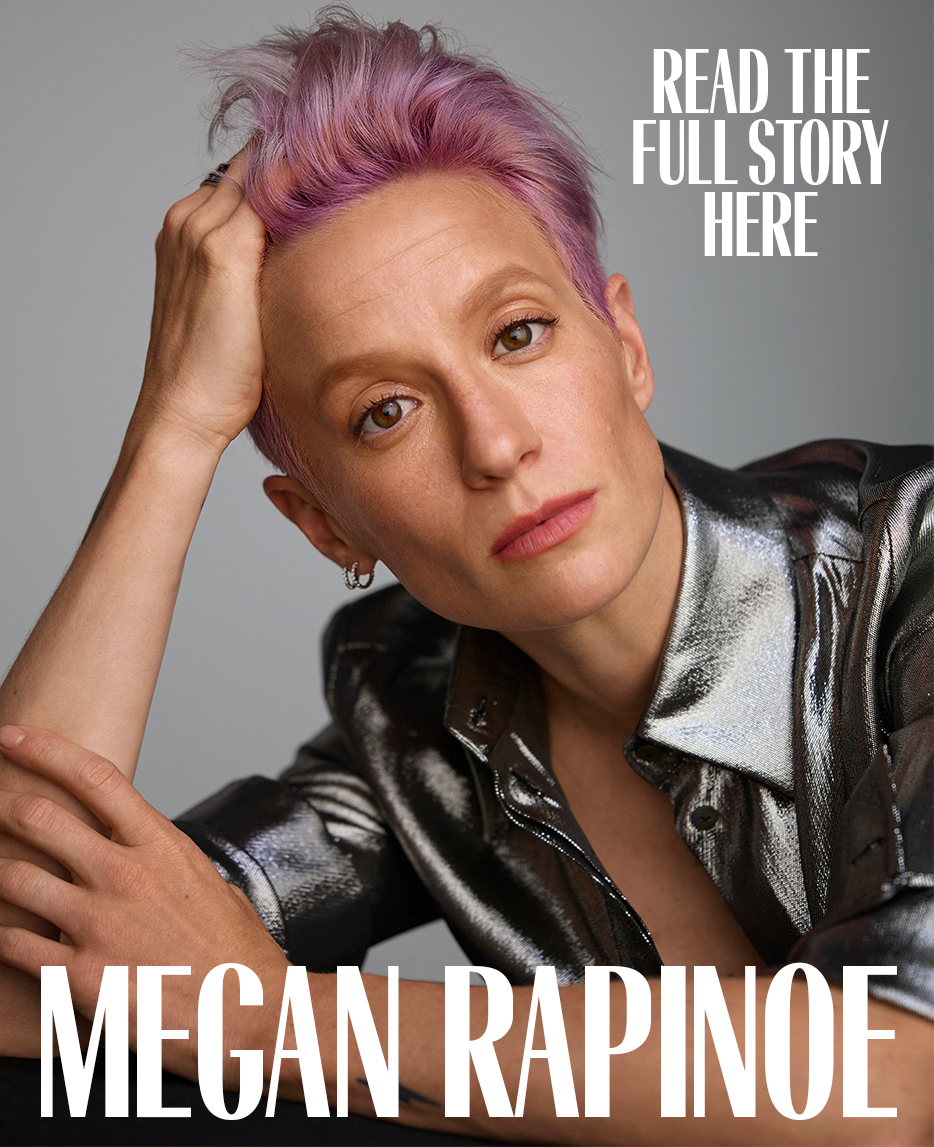
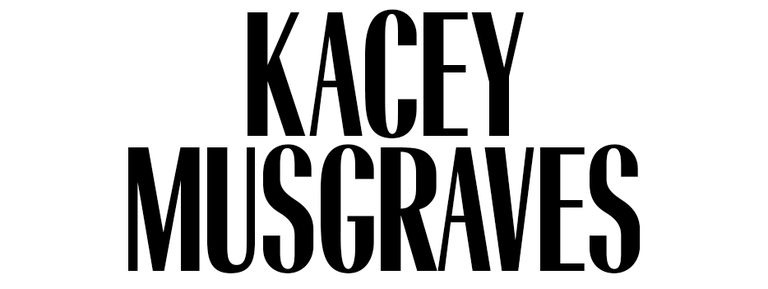
Because by proving progressive, provocative voices like hers deserve to be heard, she's redefining country music for a new generation.
When singer-songwriter Kacey Musgraves was coming up in Golden, Texas, a sawmill town in the Bible Belt, she spent as much time as possible outdoors, running barefoot through the woods, hair wild, feet dirty. Weekend nights, she dolled up and sang Western swing for folks twice her age. That juxtaposition of down-to-earth country girl and polished music prodigy has informed her outlook ever since. The contrasting touchstones lend Musgraves, 31, a palpable depth and enticing complexity in an industry that prefers its women in tidy boxes.
After her 2013 debut, Same Trailer Different Park, Musgraves shotgunned into stardom. She was named CMA New Artist of the Year in large part due to her brain-teasing lyrics, as sharp as they were melodic. She’s since won six Grammys, including four for her latest album, Golden Hour, a stirring departure from her previous wordplay and a lean into a future she’s building for herself, one deliberately more vulnerable than cerebral. “Before, my songwriting hinged more on turning phrases,” Musgraves explains. “I like that style, but I wasn’t using all the colors in the box. This time, I wanted to speak from the heart. It was time to shift gears and feel things and let people in a little bit more. I’m a perfectionist. I had to let go.” —Allison Glock
Get exclusive access to fashion and beauty trends, hot-off-the-press celebrity news, and more.
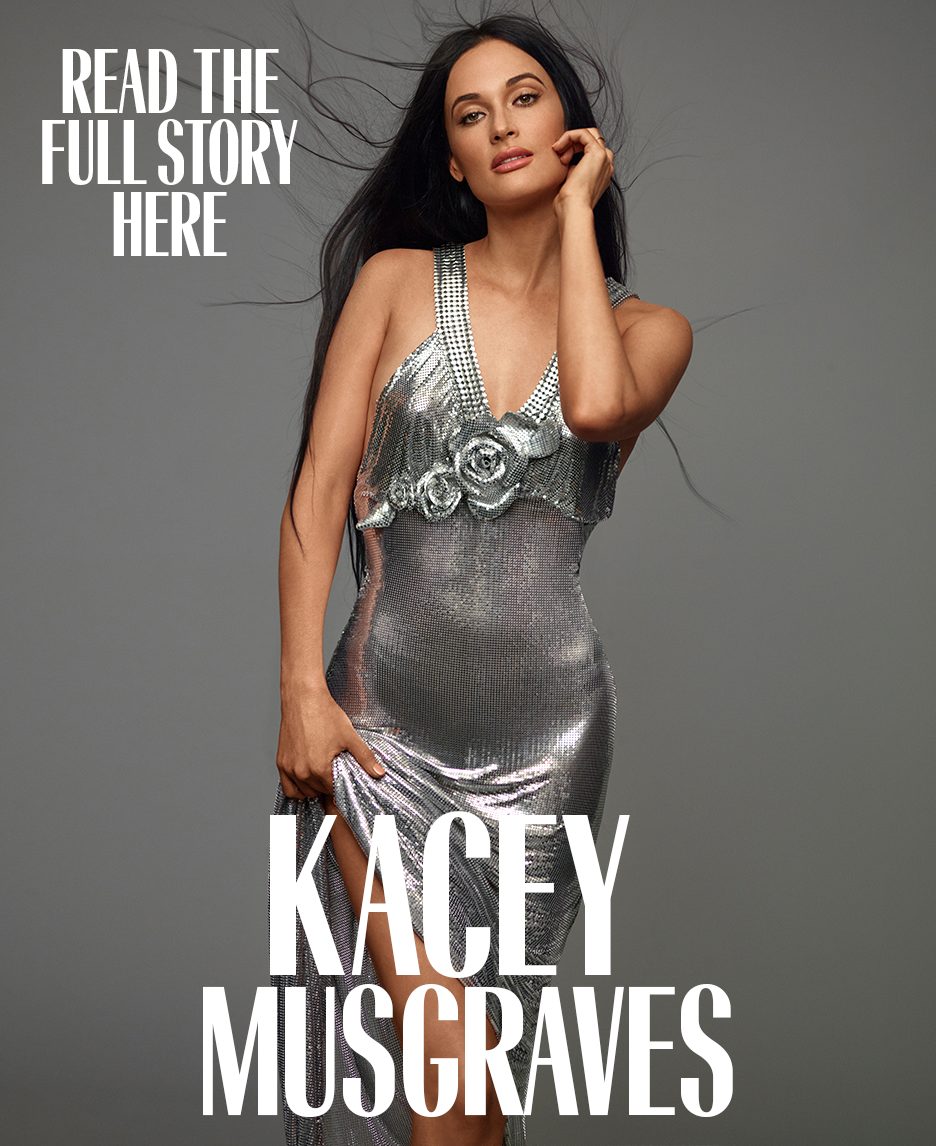

Because by shifting seamlessly from comic genius to dramatic force, social media to silver screen, she represents a next-level kind of stardom.
Asked what always makes her laugh, Nora Lum, better known as Awkwafina, tells a story about fornicating squirrels. “They were aggressively lovemaking on top of a garbage can. I went to throw out a soda, and both of them turned, looked me in the eye, and just kept going at it. I felt so disrespected.” Awkwafina busts up anew, admits she thinks about those squirrels all the time, and then, barely taking a breath, dives into another recent memory. “I was at my aunt’s house in North Carolina, outside, petting the neighborhood cat, Sushi. I might have been toking on something. Anyway, I looked down, and it was an opossum.” She chuckles again, long and hard, then asks, “Do you have a cat?”
Awkwafina, 31, is a wholly original five-foot-two-inch ball of wax. Part raunchy teenage boy, part fierce feminist, the actress-rapper is kind and irreverent and respectful of tradition and incapable of not creating something new, subversive, and sunny. Above all, she is a tidal wave of cool, largely because “cool” is the last thing she views herself as. “I’ll always be insecure,” she says candidly. “I’ll always critique myself, I’ll always want to evolve, and, yeah, I’ll always hate myself a little bit.” —A.G.


Because she parlayed YouTube megafame into a late-night hosting chair, ushering a major network into a belatedly woke future.
Lilly Singh wants to throw up. The actress-comedian is hip-deep in prep for the September 16 premiere of her late-night NBC talk show, A Little Late With Lilly Singh, a debut that will make Singh the only woman hosting on a Big Four broadcast network.
“When my show got announced, people said to me, ‘Ohhh, two billion people are counting on you,’” Singh, 31, says of the pressure funneled her way, not just a result of her being a woman breaking into a man’s world but because she’s a bisexual Indian Canadian woman unleashing a much needed swell of diversity into an aggressively vanilla landscape. She’s also encountered fan after fan relying on her to detonate the glass ceiling. “I’m not viewing that pressure as negative, to be honest,” Singh says cheerfully. “I feel lucky to be in this position. I’m a minority in many, many ways, and I want to make sure that anyone, no matter where they are in the world, can relate and feel represented.” —A.G.
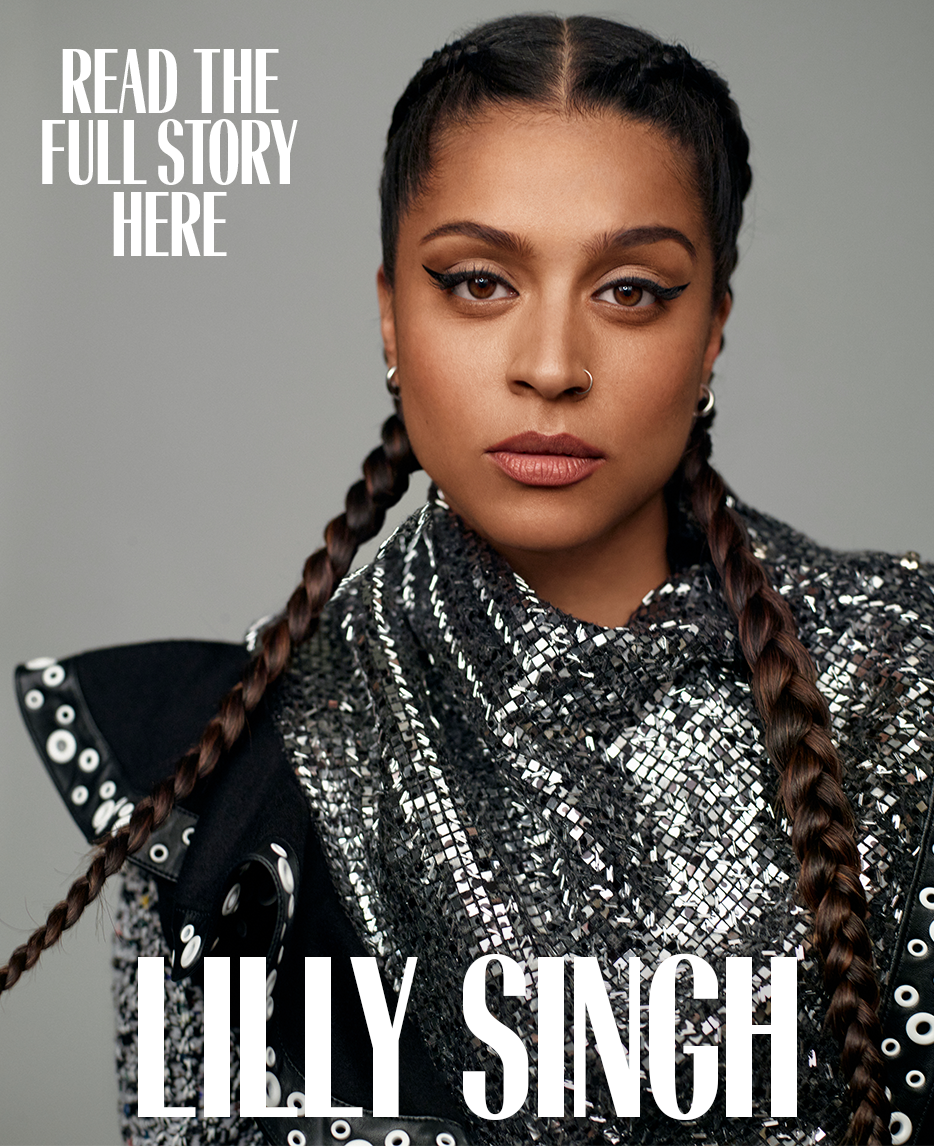
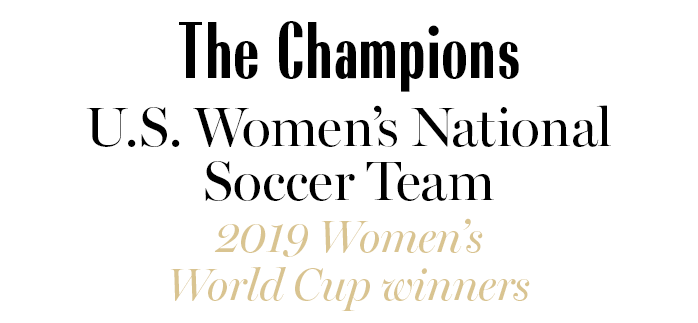
Because these literal game changers, who took home their fourth Women’s World Cup title, captivated an estimated one billion viewers while inspiring female athletes at all levels to fight for what they deserve.

Co-captain Carli Lloyd holds the trophy as the team celebrates its World Cup win, Lyon, France, July 2019.
The Story:
By suing for equal pay in the face of blatant institutionalized gender discrimination—the women play more games, which they win more of, for less money than the men’s team earns—and holding firm to their demands even as negotiations stall and the federation hires lobbyists to counter their claims, they’re showing what it takes to be a champion: bravery, strength, and determination—traits that, regardless of what happens in court next year, will serve future generations well, on and off the pitch.

Because she’s making blue-sky dreams a sky’s-the-limit (literally) reality.
Your ideal vision of space exploration in 2044:
“We are flying all over the solar system, have made measurable progress on figuring out how to fly to even more distant places, and have permanent bases (that are semicomfortable to live in) on the moon and Mars, and 50 percent of technology workers are women.”
What you're doing to make that vision a reality:
“I feel that I am (trying to) move toward this every minute of every day. The [rockets] Falcon 9, Falcon Heavy, and Dragon are doing the heavy lifting (pun intended) that creates revenue to help pay for our future projects. Our global broadband project (Starlink) will initially provide fast, reliable Internet to populations with little or no connectivity, including those in rural communities and places where existing services are too expensive or unreliable. Eventually, we’ll expand this to connect people around and between other heavenly bodies. And of course our next rocket project—Starship—is incredibly exciting. That vehicle will ferry people, supplies, and equipment between Earth, the moon, and Mars. It will also turn long-distance flights across the globe into single-hour-long trips. How great is that?”
Greatest challenge in the next 25 years:
“Gravity will always present a fierce challenge.”
What you'd tell your 25-year-old self:
“I am not a regretter. I like the way my life has turned out. But I think the following strategies have helped me be successful: Don’t be afraid to take on new, completely different responsibilities, take risks (Yes! Marry that wonderful person who is eight years younger than you), sleep enough, be helpful and kind, and laugh a lot.”
What we should know about the work you do:
“We aren’t giving up on Earth just because we are trying to get people to Mars.”
Words to live by:
“Life is way too short to drink crappy wine.”
Legacy you hope to leave:
“My two wonderful children are legacy enough. Except maybe helping humanity manage risk by enabling people to live on other planets. Just those two things.”

Because she not only uses her platform to promote feminist ideals, she also believes it’s her responsibility to do so.
Your ideal vision of entertainment in 2044:
“I’m witnessing the vision come to life as I watch space makers like Melina Matsoukas, Issa Rae, Quinta Brunson, and Nahnatchka Khan continue to expand what, and who, media looks like. I’m looking forward to new leaps and bounds in entertainment and storytelling, as well as the utilization of media to redefine and create an alternate curriculum where untold stories are centered.”

What you're doing to make that a reality:
“Whether with my engagement initiative Eighteen x 18 or through my family’s production company, we intend to increase accessibility to resources and support networks to rid this industry of ‘gatekeepers’ in exchange for community builders!”
Greatest challenge in the next 25 years:
“It is crucial to the world of entertainment to never settle for what we have. This industry is dependent on innovation through stories, and our collective progress in creating more equitable spaces is dependent on being cognizant of who is being left out of the conversation.”
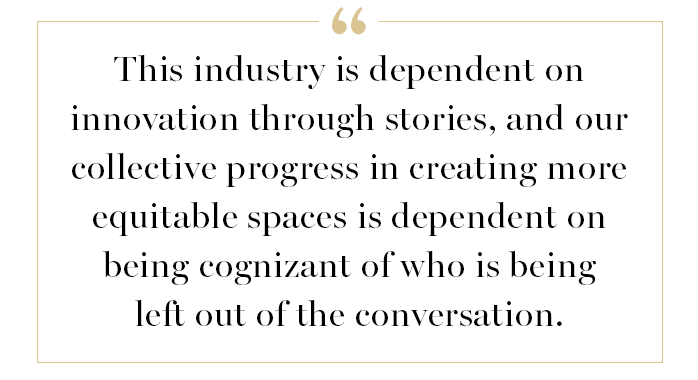
What gives you hope for the future?
"My peers constantly inspire me! I’m grateful to be amongst a generation of proud game changers who not only advocate for their own communities but constantly support their global community. Knowing that we are all invested in making the world a better place motivates me to be of service. The generation before ours put in tremendous work to create space for us, and we are not taking that for granted.”
Legacy you hope to leave:
“I’ve chosen to focus on impact over legacy. While legacy is an important means of remembering the people who have invested in future generations, I hope that by defining my life based on impact and purpose and figuring out how I can be of service on a daily basis, it will outweigh any perceived notoriety I’ve gained from my acting work. I aim to use my platform in any way I can to make the world an identity-celebratory space that highlights our universal humanity.”

Because with the best-selling fantasy Children of Blood and Bone—to be adapted for the big screen by Lucasfilm—the writer has opened up a magical, mystical world for YA readers, especially audiences of color, for whom representation in children’s literature is scant. The second in the West African– inspired Orïsha trilogy, Children of Virtue and Vengeance, comes out in December.
How has your field changed in the last 25 years?
“Storytelling has definitely changed for the better. If you look at the New York Times best-seller list today, you can see that a story about a black girl taking on police brutality has been the number-one-selling young-adult book in America for over two years. Children of Blood and Bone just celebrated its 75th week on that same list. If I’d tried to publish this story a decade ago, it would’ve been rejected or I would’ve been told to make all my characters white. We still have a long way to go as an industry, but we have certainly made great strides for diversity.”
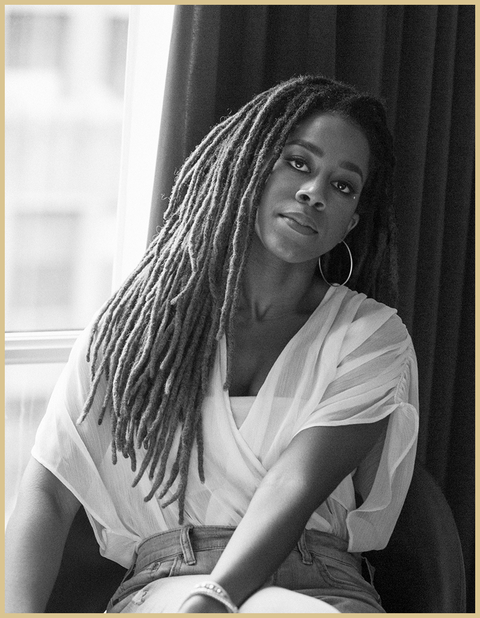
Your ideal vision of publishing in 2044?
“An industry whose books and writers reflect the diverse population we live in. I’d also want to see that diversity reflected within the publishers at all levels and across all jobs.”
What you're doing to make that vision a reality:
“I intend to use my voice and platform to put as many diverse stories and creators into the world as possible. I have tremendous respect for storytellers like Issa Rae, Shonda Rhimes, and Ava DuVernay, who all use their work to uplift and employ marginalized creators and tell stories we haven’t been allowed to see on screen. I’m excited to continue growing in my field and follow in their examples as I gain new opportunities.”
Greatest challenge in the next 25 years:
“Fighting complacency. I mentioned that we’ve made great strides in diversity, but we still have a long way to go. While there are several commercial and award-winning successes we can point to that champion diversity, as a whole, children’s literature is still suffering. A 2018 infographic on diversity in children’s books reported that while 50 percent of books had characters depicting white characters and 27 percent had animals, only 10 percent had African or African American characters, 7 percent had Asian Pacific Islander or Asian Pacific Americans, 5 percent had Latinx characters, and 1 percent had American Indian or First Nation characters. We’re still writing in an industry that’s had centuries of books full of mostly all white, straight, cisgendered casts. We have a lot of work to do to create lasting change.”

What you'd tell your 25-year-old self:
“‘Get ready to meet yourself. It’ll be rough, but you’re going to like her. She’s a fighter.’ I just celebrated my 26th birthday, and I feel like I’m getting to step into it feeling truly comfortable in my skin because being 25 was the most challenging year of my life. I had to weather several personal and professional conflicts. I felt more drained than I ever had. But as I fought through each problem, I felt like I was meeting another piece of myself. I learned how to stand on my own two feet. I learned to be comfortable taking up space. I learned to be relentless about pursuing my needs and to remove the limits from my wildest dreams. I still have so much to learn and so many new places that I want to grow, but I know I’ll be carrying those lessons with me for the rest of my life.”
Legacy you hope to leave:
“When I get to the end of my life, I hope I can measure it in how many dreams I helped come true. It’s kind of a report card I’m keeping for myself. More than any individual story I bring to life, I hope that I get to be an example to people that they can go for their dreams as long as they’re willing to persevere and give it their all.”
Proudest moment:
“When Beyoncé put my picture on a collage for Black History Month with black icons like Martin Luther King, James Baldwin, Malcolm X, Tarana Burke, and Pat McGrath.”

Because the greatest gymnast the world has ever seen will have tomorrow’s athletes chasing her every record.
How has your field changed in the last 25 years?
Recently, there has been a great amount of attention brought to the sport regarding sexual and physical abuse to the athletes, which has been extremely difficult to comprehend and process. But thanks to so many brave people and survivors our voices are being heard and, ultimately, I hope that this attention will result in real change in the organization and provide a new focus on athlete safety as the priority.
Your ideal vision of gymnastics in 2044:
I wish for true transparency to exist in the sport and for policies that will protect the athletes—which should be happening now and not take 25 years. I am also hopeful that athletes who compete for their country will be paid fair wages and be able maintain their college eligibility despite turning pro. I would have loved to have had the opportunity to compete as a college gymnast.
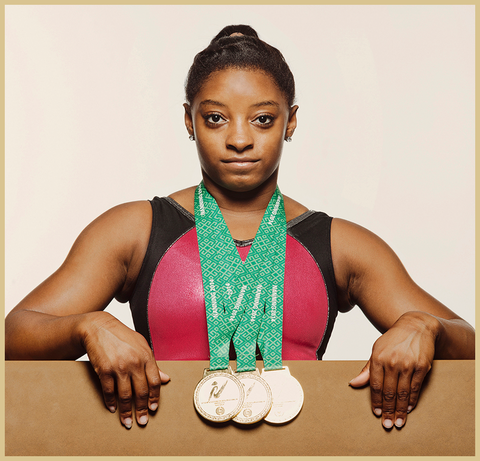
What you're doing to make that vision a reality:
I am speaking out more. None of this easy, but we deserve better and I plan to continue to advocate for this even beyond my competition days.
Greatest challenge in the next 25 years:
The current (archaic) rules that USAG uses to govern our sport. I believe that actions speak louder than words and it’s time for real change.
What you'd tell your 25-year-old-self:
Stay active and engaged in the sport; there is still work to be done. Continue setting goals and fight for them, both in and out of the gym.
What gives you hope for the future?
I feel that there is finally a crack in the system where women's rights matter and abuse of any kind should not be tolerated or accepted. I feel that speaking out is becoming the norm; no one should feel afraid to use their voice.
Proudest moment:
Winning the All-Around gold medal in the 2016 Olympics!
Legacy you hope to leave:
I am passionate about gymnastics and it’s what I love to do, but it’s not who I am. My hope is that, if anything, I inspire others to embrace their dreams and encourage them to soar, even in the face of adversity.

Because as the first person in a wheelchair to win a Tony Award (for Oklahoma!), she shows the world that the disabled are not their disabilities.
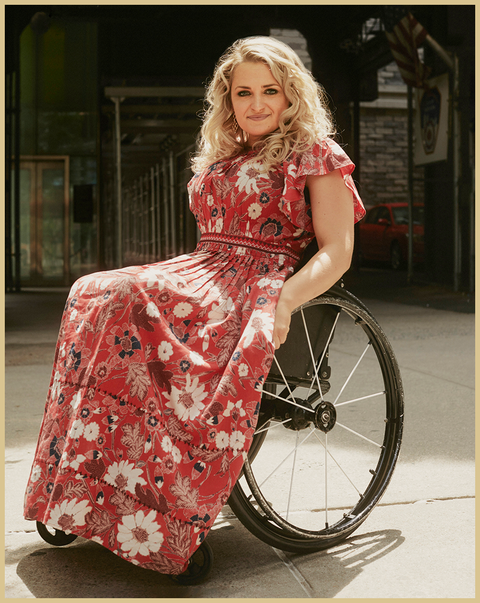
Because as the first person in a wheelchair to win a Tony Award (for Oklahoma!), she shows the world that the disabled are not their disabilities.
Your ideal vision of theater in 2044:
“I hope to see more gender equality and representation of people with different abilities. I hope more of the entertainment industry becomes educated about accommodations that are available for people with disabilities so that there is less fear about hiring them as actors and crew.”
Words to live by:
“Make your limitations your opportunities.”
Legacy you hope to leave:
“I hope to always remind people that your limitations don’t have to define your life and to always go after your dreams!”

Because she marches to her own tune.
Your ideal vision of music in 2044:
“That people like what they like and not what other people like.”
What you're doing to make that vision a reality:
“I’ll keep doing what I do.”

Greatest challenge in the next 25 years:
“It’s hard to be a female in this industry. Hopefully that dies down.”
What gives you hope for the future?
“My fans.”
Words to live by:
“Do what you want now, before it’s too late.”
Legacy you hope to leave:
“That doing whatever you want actually works sometimes."
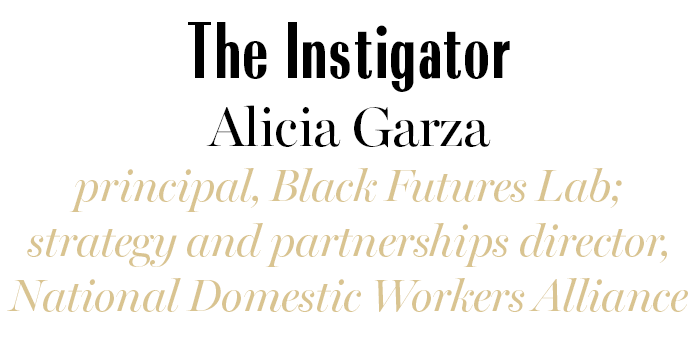
Because she inspires resisters, persisters, and sisters.
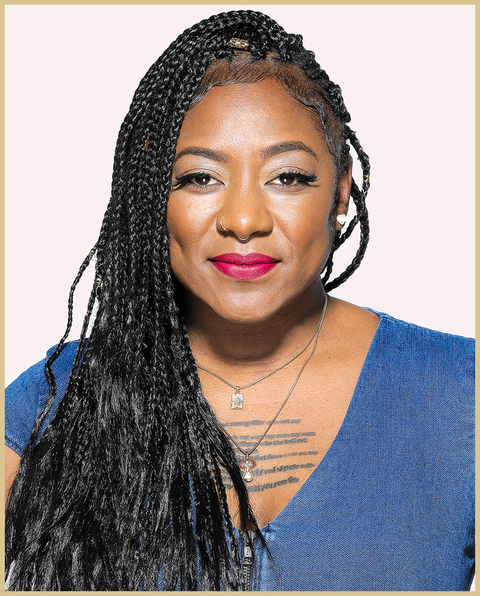
Your ideal vision of activism in 2044:
“Honestly, I hope we have a planet to fight for! In 25 years, I hope black communities are powerful in politics. I hope that we’ve won back many of the victories that have been eroded under this administration, and I hope that we have protected everyone’s right to participate and have a real say in the decisions that are impacting all of our lives. The people we count on to care for the people we love will have rights and dignity, and the federal Domestic Worker Bill of Rights will be the law of the land.”
What you're doing to make that vision a reality:
“That’s what the Black Futures Lab is designed to do: make black communities powerful in politics. It requires demanding more of our elected officials, providing relevant information to our communities that reflects how we experience the world, and it requires building political power. In my work at the National Domestic Workers Alliance, we’ve already built a powerful vehicle of 30,000 domestic workers across the nation who are fighting to live a good life, and in July, we did something that took nearly 80 years to accomplish: We introduced a federal Domestic Workers Bill of Rights.”
What gives you hope for the future?
"People who are getting involved in activism or organizing right now. We need more people who take on the responsibility of making sure the country works well for everyone, not just a small few. Building and maintaining a healthy, multiracial democracy where everyone gets to participate is all of our work.”
Legacy you hope to leave:
“For black communities to know that we are powerful beyond measure and deserving of having what all people need to live with dignity.”

Because she’s putting people’s health in their hands.
How has your field changed in the last 25 years?
“Sequencing the human genome first became feasible and then became accessible. It’s now less than $100 to get access to a broad genetic assay. As a result of the drop in costs, we went from having one human sequenced to now millions. As the technology has become broadly accessible, it has raised important questions about privacy and use of the data that continue to be discussed and debated. The value, however, in having millions of individuals sequenced will be the discoveries we can make that lead to new disease treatments and new insights into disease prevention and health optimization.”
Your ideal vision of genetics in 2044:
“That it becomes an important and significant part of our health and society. I believe there will be significant advancements in understanding, treating, and preventing diseases that will impact everyone. This could lead to new and personalized treatments or personalized wellness plans that help prevent disease. I also believe that the more people learn about their own DNA, the more they will recognize their connection to everyone on the planet.”
How you define progress:
“I’d like to impact health care and quality of life. Success for me would be increasing the number of people who are healthy at 100 and who have been able to avoid preventable diseases or have been treated by medicines that came out of genetic research.”
What you'd tell your 25-year-old self:
“To enjoy the uncertainty and take advantage of every opportunity that comes your way. You never know what opportunities will be meaningful in your life, and you cannot predict how life will evolve. When you have nervous butterflies in your stomach, embrace the fear and know you are growing!”
What's next?
“We have done a lot to help people access and understand the human genome, and we are now focusing on how people will benefit. One of the first ways is by preventing disease. If people know they are at increased risk, how can we help them manage that risk to prevent the disease? Second, we can help people benefit by using genetic insights to discover and develop medications to treat disease. We started a drug discovery program four years ago and now have a number of programs underway.”
Legacy you hope to leave:
“I want people to feel that getting access to their genetic information was the first step in feeling empowered and in control of their health. I hope that feeling bleeds into their overall health-care experience and individuals ask for and achieve more control over their health and the care they receive.”
Greatest achievement
“Knowing that 23andMe has reunited families, answered unknown questions, and saved lives makes me feel like we are on a worthy mission.”

Because she’s making sustainability look good.
How has the fashion industry changed in the last 25 years?
“The mass consumption of clothes has gotten the world into trouble. It’s a similar process to what happened in the food industry: Industrialization went too far. I go to the grocery store and see precut grapefruit wrapped in plastic wrap and stored in a plastic container. When did we get too lazy to peel a grapefruit? The food looks good, but it’s not good for you. I see that same parallel with clothing. Fashion became just about the look of clothes, and there was not a thorough thought process behind how things were made.”

Your ideal vision of fashion in 2044:
“There is no clear path to sustainability, but you start little by little, find your challenges, and learn. There are ways of offsetting your carbon footprint; there just has to be the will to do it.”
What you're doing to make that vision a reality:
“I was telling a scientist about all of our efforts over the past five years—choosing sustainable materials (we use natural fibers), avoiding viscose to save trees, developing biodegradable packaging that breaks down in 24 weeks versus 500 years—and she said, ‘This is all great, but if you’re shipping product by plane, you may as well not be sustainable. Ship by boat.’ Now we are trying to install a program to ship by boat. At Fashion Week this past September, we were the first show ever to measure our carbon footprint, and we’re going to offset it by planting trees. I also want to stop using virgin materials over the next two years and use only recycled fabrics.”
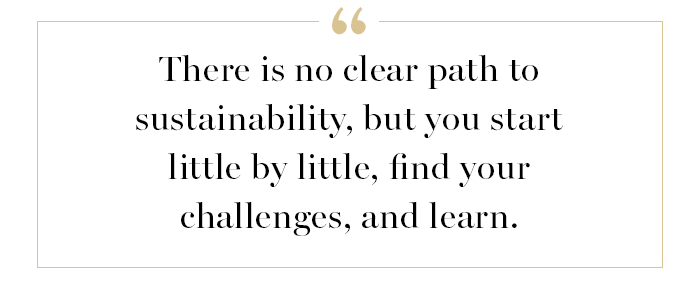
What gives you hope for the future?
“I have a lot of hope in artists and scientists. You need both creativity and data to go places.”
Legacy you hope to leave:
“I want my children to know that I wasn’t on the sidelines.”

Because she’s serving up a forward-thinking model for how a restaurant could be run.
Your ideal vision of the landscape in 2044:
“I envision a world where accessible, central, and high-quality parental support is the norm and parents can have more flexibility and freedom to develop their careers within our industry. In parallel, wellness in the workplace is taking root as a lifestyle shift. The intense pace and physical demands of working in hospitality will be sustainable only if we meaningfully integrate wellness into our daily practice. If we can’t take care of ourselves, then how can we truly serve others? The realities of climate change are also deeply connected to our field. We must transition how our food is grown and consumed at all levels.”

What you're doing to make that vision a reality:
“We exclude the labels ‘front of house’ and ‘back of house’ and implement equal pay across all team members, regardless of position. Furthermore, we have no porters or dishwashers, an often-ignored subclass of restaurant teams. Rather, every team member learns how to execute every function, from culinary craft and coffee service to taking care of guests to wine pairing. This adaptable training model makes scheduling effective and productive but also, most notably, allows us to hire individuals with no previous experience. Our Embrace Your Side Hustle program (a monthly stipend to help the team accomplish goals beyond West-Bourne), Mindful Minutes (a preshift breathing and meditative exercise), and town-hall meetings are just a few ways we keep our team happy, grounded, and healthy. Our sustainability practices include a waste-efficient menu (in which food scraps are upcycled into offerings such as compotes and sauces), a food-waste compost system, compostable tea bags and to-go packaging, recycled denim napkins (courtesy of Atelier Saucier), eco-friendly cleaning products, and energy-efficient equipment.”
What you'd tell you 25-year-old self:
“Life is interconnected and unpredictable. It’s not a racetrack. There is no one end point or singular goal. The first step is to surrender to that. The second is to find value in the journey and move toward your own self-fulfillment by forging a distinct path. And by the way, that path may not feel overtly specialized. That’s OK. There’s a lot to be gained by being a generalist. Having the foundation to understand where everyone at the table is coming from, and feeling competent across different disciplines to problem solve and think creatively, that’s everything.”

Because she’s working to ensure everyone who can vote is allowed to.
Your ideal vision of politics in 2044:
“In 25 years, our nation will finally have embraced free and fair elections, and we will institute inviolate rules to guarantee access without regard to race, class, geography, or status. The right to vote is the sole guarantee that our political process will become more representative and orient itself to address the pressing needs of the American people.”

What you're doing to make that vision a reality:
“I have not only run for office, I have founded organizations whose work has ranged from ensuring full implementation of progressive public-policy goals to securing the fundamental right to vote and be counted. Most recently, I launched Fair Fight Action, an organization dedicated to ending voter suppression through litigation, legislation, and advocacy. I also founded Fair Count to ensure that the hardest-to-reach populations will be included in the 2020 census and the allocation of public resources. I will continue to exercise leadership and work relentlessly against the voter suppression and attempted census erasure that pose the greatest existential threats to our democracy.”
Greatest challenges in the next 25 years:
“Voter suppression, timid policymaking, and acceptance of the status quo in poverty and economic deprivation combine to create a triad of challenges to true, achievable progress. When policy makers and politicians fail to fully engage the identities and obstacles for these folks, we risk losing a golden opportunity to harness their transformative energy and resonant voices. We cannot resign ourselves to more cycles of cynical, unrepresentative politics. Our greatest challenge and most vibrant opportunity is to recognize the diversity of our communities, meet them where they are, and commit to removing barriers to full engagement.”

What you'd tell your 25-year-old self:
“I had the rare opportunity to write a book of advice for my 25-year-old self in Lead From the Outside. But, to sum it up: Do not edit your ambitions, know fear is real and befriend it, being broke does not make you a bad person, and failure is inevitable but not fatal. Too often, at the quarter-life mark, we have done just enough to either assume our trajectory is inevitable or to decide we have made too many mistakes to recover. Neither is true. Remember, the person you are becoming will benefit from your errors as much as your triumphs, and you are gaining ammunition and energy for the next round.”
What gives you hope for the future?
“We are, both at home in America and around the globe, facing a demographic shift that can fundamentally change the future of our world. Whether in a district attorney’s race in Ferguson or in the overthrow of a dictator in Sudan, new voices are working hard to ensure that our political process reflects their day-to-day realities. As a daughter of the South, I take great heart from the persistence of effort to secure our rights, preserve our humanity, and share the battle with those who know we are capable of so much more.”
Legacy you hope to leave:
“My legacy will be a relentless battle against poverty and its consequences: inadequate education, over-incarceration, poor health outcomes, lack of access to opportunity, and the dehumanization that allows us to turn a blind eye to the crippling effects of lack. Every day, I will focus my efforts on the end of voter suppression, full voter engagement, a fair census count, a business life that does well and does good, and the dogged pursuit and adoption of public policy that truly lifts communities out of survival and into success.”

Because she embodies what global leadership looks like in times of crisis.
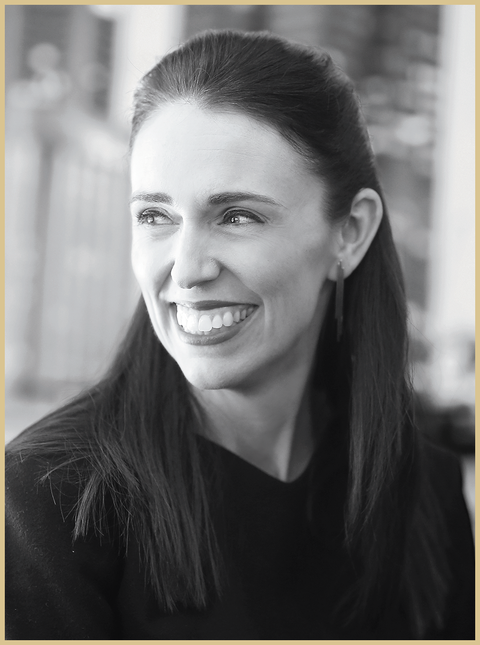
The story:
After 51 people were killed at two mosques in Christchurch, the world’s youngest female leader was an exemplar of strength, compassion, and swift action. She wore a hijab in solidarity with the victims and their families, refused to speak the terrorist’s name, and, within weeks of the attacks, rallied Parliament to ban military-style semiautomatic weapons and assault rifles. At press time, she is working to decriminalize abortion in her country. For citizens anywhere jaded by weak-willed and ineffective leadership, Ardern shows how to get things done when things need doing.
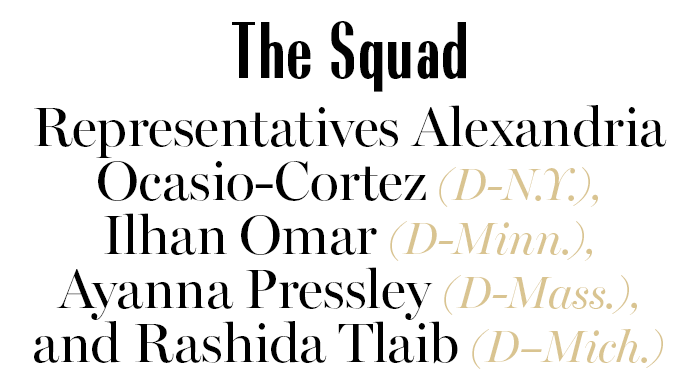
Because they don’t back down from a bully, even when it’s the president.
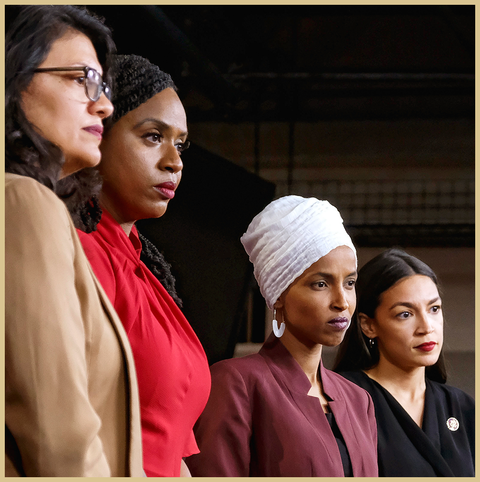
Congresswomen Tlaib, Pressley, Omar, and Ocasio-Cortez, at a press conference at the U.S. Capitol, July 2019
The story:
In the face of a vitriolic, racist attack from Donald Trump, who tweeted the four legislators should “go back” to their home countries (all are U.S. citizens; three were born here), they have shown unity, grace, and unflinching resolve—demonstrating what the new face, and tone, of politics should look like. The freshman representatives have upended business as usual in Congress—a body where years of service and your connections generally determine the amount of power you have—and prove that our country’s history doesn’t have to be its future and that women can and should make an impact on the political stage. Our voices are too powerful to ignore.
What you'd tell your 25-year-old self:
“When your gut is telling you to do something because you believe it is the right thing to do, do it! Don’t hesitate. At the end, justice and doing the right thing feel much better than regret,” says Representative Tlaib.

Because she’s a quadruple threat as the actress, writer, director, and cocreator of Russian Doll, which scored 13 Emmy nominations in its debut season on Netflix.
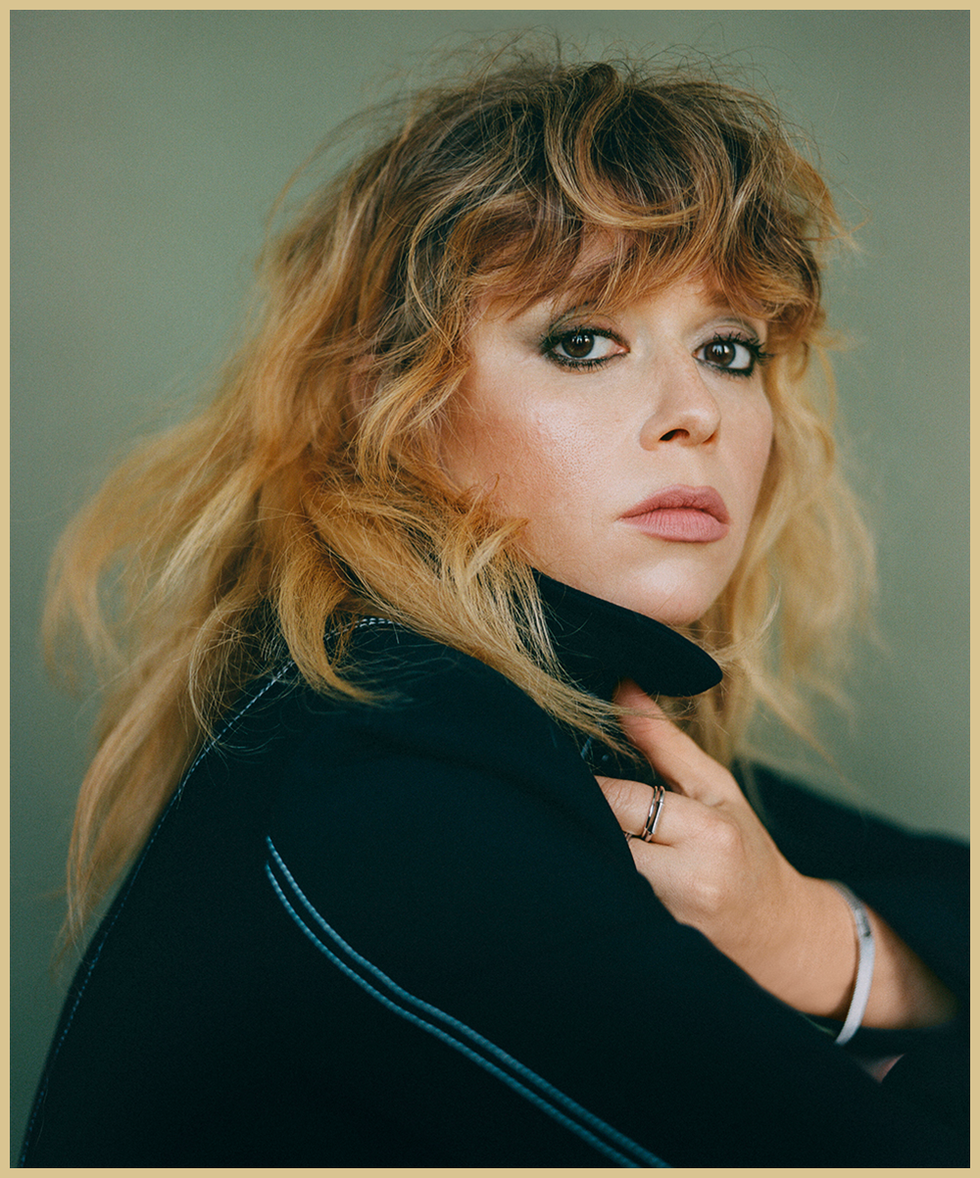
The story:
Make that quintuple because her Animal Pictures production company with Maya Rudolph inked a first-look deal with Amazon Studios. Hers is a reversal of fortunes: After a promising career was derailed by drugs and run-ins with the law, Lyonne emerged from the turmoil and landed a seven-season run on the critically lauded Orange Is the New Black, proof that there are second acts.

Because at 16, she seems to be the only adult in the room rallying world leaders to do something about climate change.

Your ideal vision of activism in 2044:
“My highest ambition is that there will be no climate and environmental activists, because that would mean that everything is fixed if no one needs to protest against inaction or destruction. Also, that we have come to our senses and come together so that we don’t have to worry about this in the future or make this mistake again.”
What gives you hope for the future?
“The people who are standing up for the future, who are fighting every day to keep the fuels in the ground and so on, and also the Fridays for Future movement [schoolchildren demanding global leaders take action on climate via protests].”
Legacy you hope to leave:
“I don’t hope to leave a legacy. I just want to be able to look back and say that I did everything I could, and that is what I’m trying to do. I have promised myself to do everything I can while I can. So that is what I want my so-called legacy to be.”
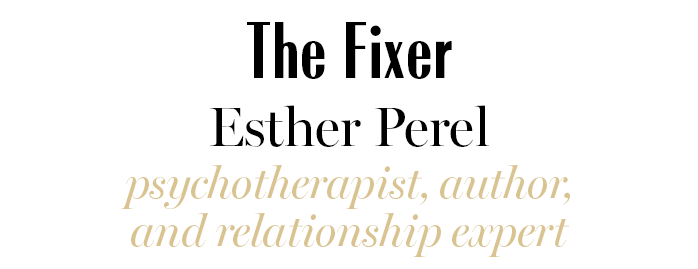
Because she’s challenging conventional notions of relationships, romance, intimacy, love, and sex.
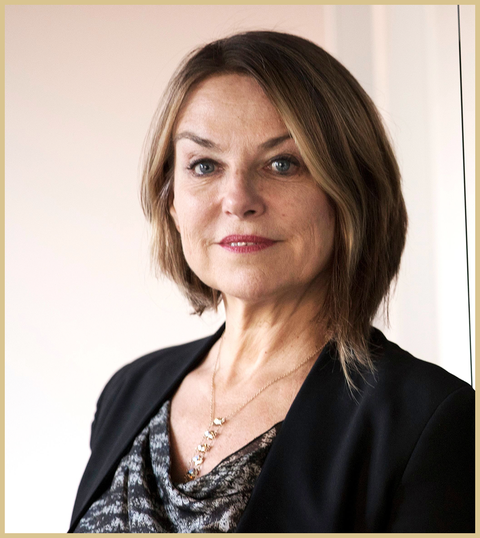
Your ideal vision of the landscape in 2044:
“We often think of relationships between two people, but in the future I’d like to see more consideration of relationships between communities, groups, and countries. Could the global community wake up and grant all people a sense of dignity, respect, and freedom? I’d also like to see progress on nine key social battles. Today, these are central pillars of the relational landscape, and I think they will probably still be on the map in 25 years:
- Destigmatizing mental illness.
- Comprehensive sexuality and relationship education for all.
- Integration of sexual health as part of relational health and overall health.
- Funding for research on male and female sexuality that goes beyond the entrenched biases. That includes research on female pleasure and on male lack of desire.
- The rise of friendship parenting, between adults who want to coparent but not necessarily be in a singular committed relationship.
- Family planning and marital rights for all.
- New and expanded definitions for what it means to be a man in the 21st century.
- Parenting based on competency rather than just gender.
- Expanding our views of sexuality along the lifespan and broadening our understanding of love and sex after 60.”
What you'd tell your 25-year-old self:
“I often have said, ‘I wish I had the looks of my youth with the confidence of today.’ At 25, I acted confident but often felt like a shaking leaf inside. There is no way to tell a 25-year-old that experience and maturity are needed to gain self-confidence; that takes time and living. I wish I had also known then this beautiful quote by the psychiatrist Carl Jung: ‘I am not what has happened to me, I am who and what I choose to become.’ I often ask this question of others at dinner parties too. I’ve found the answers usually veer into one of two directions. Some people say, ‘I was so afraid, inhibited, and overly restrictive, and I wish I had given myself more permission to explore love and life more fully, to dare and take risks, but I always held back. In retrospect, I did not really need to.’ On the other end of the spectrum, they say, ‘I wish I had not wasted my life, been so aimless, drunk, afraid to love, all over the place, without anchor, hopping from one bed to another.’ ”
The moral of the story:
“Some think they were too loose and careless, others too restrained and overly careful. Perhaps it is life and experience itself that helps people find the balance.”

Because she reassures others that they are seen and eschews the term “role model” and embodies the term “possibility model.”
Your ideal vision of TV in 2044:
“People on the margins take center stage and the reins of their own stories, which will enable us all to truly see folks how they see and experience themselves. It’ll be a truly authentic, self-created gaze.”
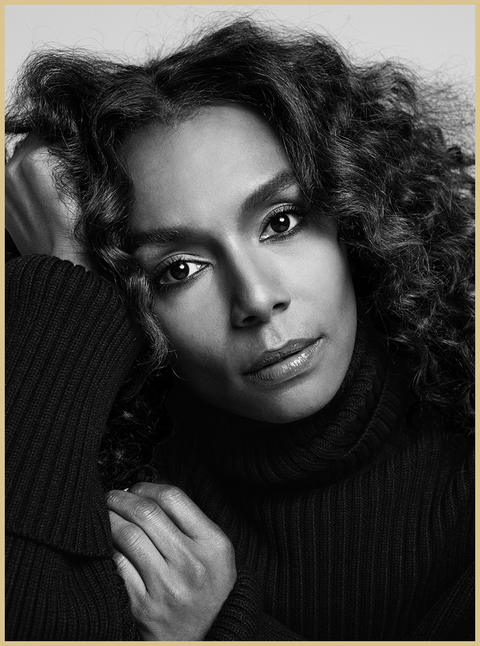
What you're doing to make that vision a reality:
“With my deal with Netflix [a three-year agreement that gives the streaming service exclusive rights to TV series and first-look option on films, making Mock the first transgender woman given creative control at a content company], I will create content that centers on those often invisibilized and uplift underheard voices emerging in Hollywood.”
Greatest challenge in the next 25 years:
“We continue to prioritize the perspectives of those who for too long have dominated the cultural narrative—those who are white, cisgender, straight, and/or male—and those with the power to greenlight content come from those dominant narratives, which blocks our ability to hear, tell, or see those who are so often ‘othered.’”
What you'd tell your 25-year-old self:
“Forget about texting him. Go home and write.”
Legacy you hope to leave:
“I would love for people to say, ‘She spoke unspoken truths. It didn’t free only her but many others too.’”
This story appears in the October 2019 issue of Marie Claire.
Clarification: This story has been updated to include answers from Simone Biles, which were not available at press time.
Marie Claire is committed to celebrating the richness and scope of women's lives. We're known for our award-winning features, thoughtful essays and op-eds, deep commitment to sustainable fashion, and buzzy interviews and reviews. Reaching millions of women every month, MarieClaire.com is an internationally recognized destination for celebrity news, fashion trends, beauty recommendations, and renowned investigative packages.